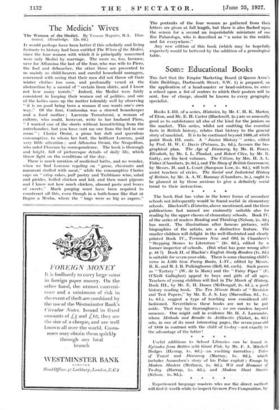The book that has value in the lower forms of
secondary schools not infrequently would be found useful in elementary schools. Blackwell's Histories, above mentioned, and the three publications last named are eminently suitable also for reading by the upper classes of elementary schools. Book IV. of the series of readers Reading and Thinking (Nelson, 2s. 3d.) has merit. The illustrations after famous pictures, with biographies of the artists, are a distinctive feature. The smaller children will delight in the well-illustrated and clearly printed Book IV., Treasures New and Old, in Chambers's " Stepping Stones to Literature " (2s. 6d.), edited by a former inspector of schools. (But what has gone wrong after p. 48 ?) Book II. of Blackie's English Study Readers (Is. 9d.) is suitable for seven-year-olds. There is some charming child's verse in Little Gcm Poetry Books, I.-IV, edited by Messrs. R. K. and M. I. R. Polkinghorne (Bell, 6d. each). Such poems as " Tartary " (W. de la Mare) and the " Fairy Piper " (F.
O'Neill Gallagher) appeal to boys and girls of all ages. Teachers of young children will find in The March of History,
Book III., by Mr. E, H. Dance (McDougall, 2s. 4d. ), -a good
history reading book. The Ten Minute Books of " Revision and Test Papers." by Mr. it J. S. Lay (Macmillan, 9d., Is.,
ls. ed.), suggest a type of teaching now considered old-
fashioned. Nevertheless these books are not to be put aside. That way lay thoroughness ; we are careless beyond measure. One might call in evidence Mr. H. J. Larcombe, whose Methods and Results in Arithmetic (Nisbet, 4s. 6d.) sets, in one of its most interesting pages, the seven-year-old of 1848 in contrast with the child of to-day—not exactly to the advantage of the latter !














































 Previous page
Previous page